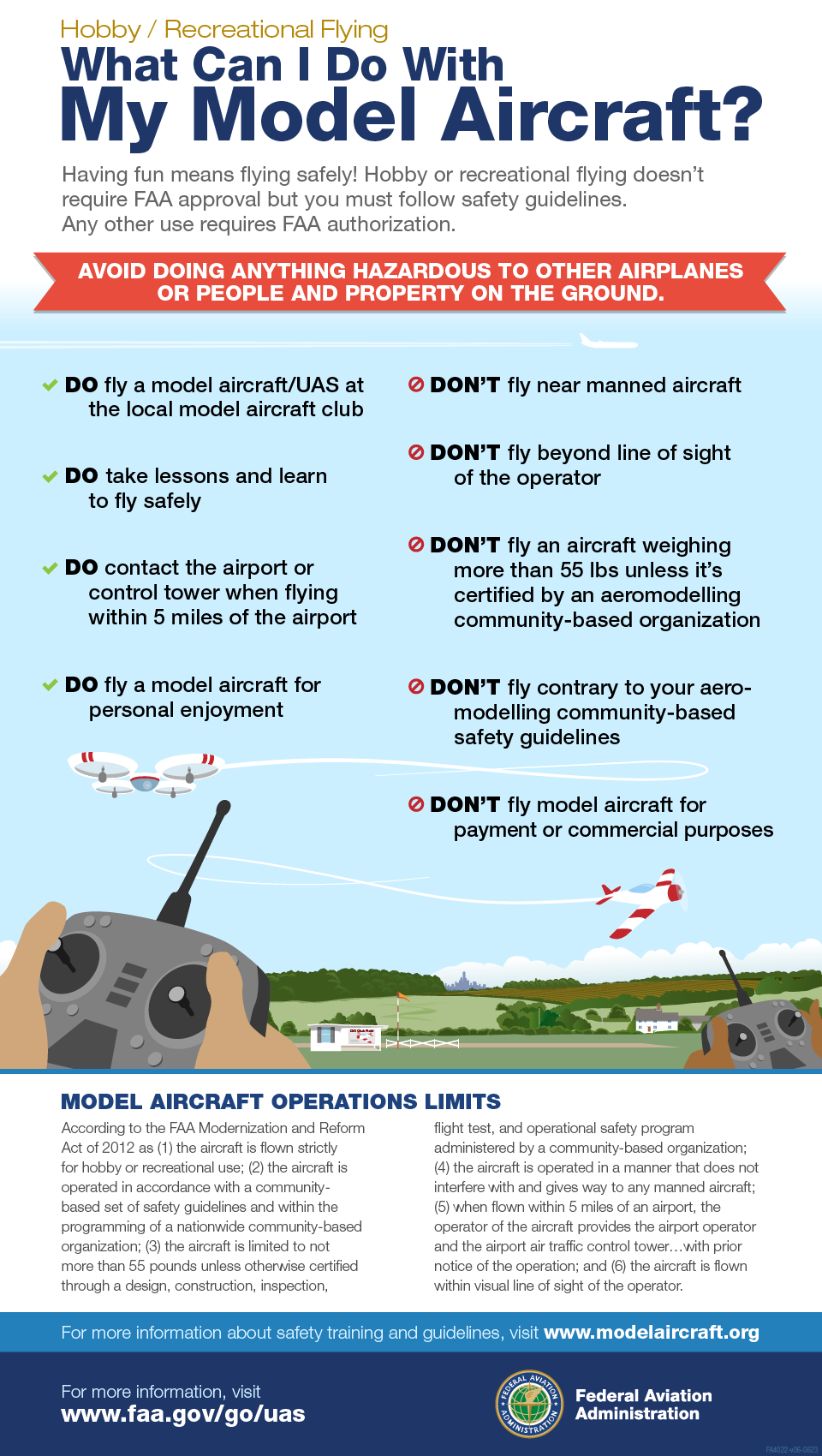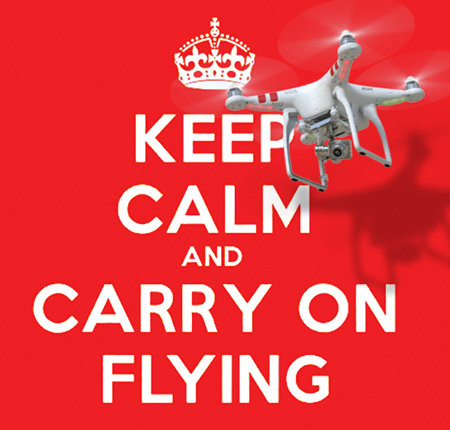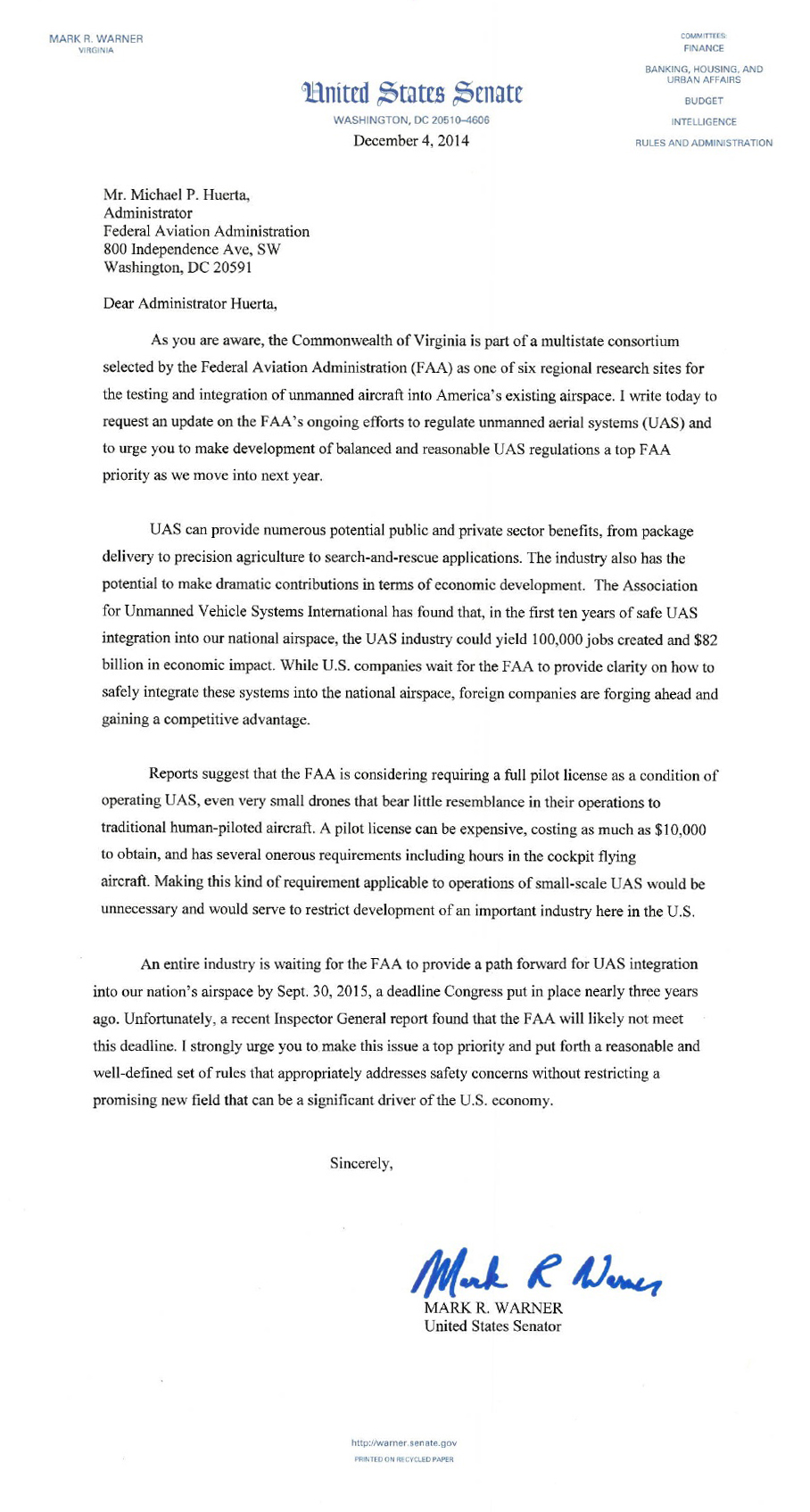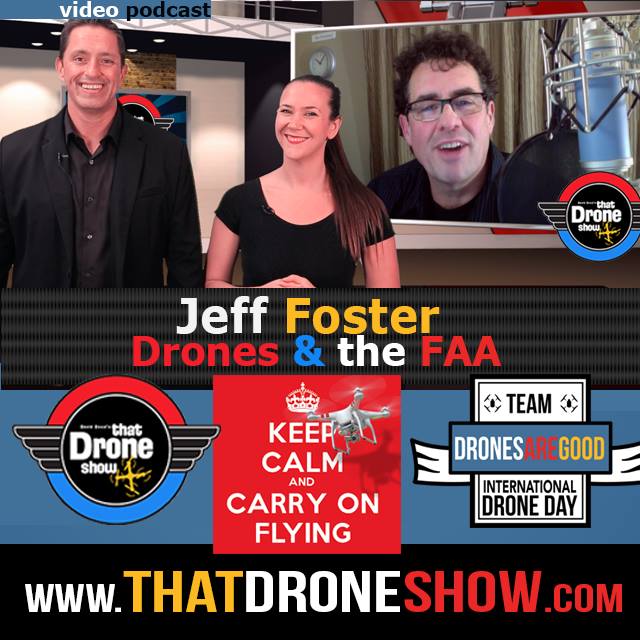With the publishing of Jack Nicas and Andy Pasztor's speculative and interpretive article in the Wall Street Journal this past week, it seems every news agency, media outlet and publication has totally lost their minds in a fit of hysteria liken to Chicken Little proportions; sparking “end of days” tweets and forum discussions throughout the social mediasphere that has brought on an industry-wide panic akin to Orson Wells' War of the Worlds live broadcast radio play. Let's just stop right there and breathe for a moment – turn off the TV, put down that paper and let's look at some facts… (UPDATED 12/10/14)
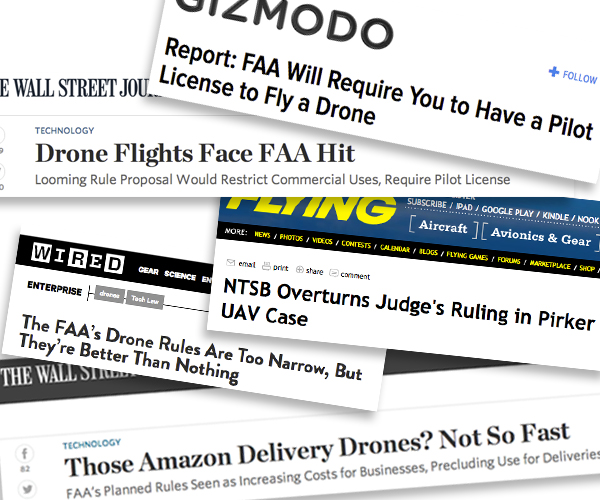
If you're new to the sUAV (small Unmanned Aerial Vehicle) and sUAS (small Unmanned Aerial Systems) or “drones” industry and are only reading the headlines today or hearing the rumors and fears of those around you (or on TV) then you probably think that sUAV you bought or were thinking of buying for the holidays is just going to have to sit on the shelf until the FAA gets around to making up the new regulations for the industry.
You might think… but you'd be wrong.
First of all, the FAA can't make laws – only develop guidelines and regulations. The federal government has no authority whatsoever to regulate the operation of remote-controlled model aircraft.
Let's back up a little and look at how the FAA has been kicking the can down the road for several years now:
Since before 2008, there have been the same restrictions and rules in place that the FAA has been clinging too, that has made it nearly impossible for commercial, industrial, agricultural, search and rescue, forest service, firefighters and *law enforcement to get full, proper authorization to use sUAVs in their work. Even the Washington State Department of Transportation had to write up a 27-page report (PDF) on the application process for test vehicles and how it was the main barrier to entry in the industry. *Note that special applications are now available for sUAVs in public service, but they need to be requested and applied/approved by the FAA.
Chris Anderson (Founder/CEO of 3D Robotics) wrote this Regulatory FAQ on his blog DIY Drones back in March of 2008 showing that really, nothing has changed in 8 years!
In as early as 2010, the discussions of the FAA sUAS regulations NPRM (Notice of Proposed Rulemaking) were open for public commenting through mid 2011. These deadlines have been continually extended all the way up thorugh Sept, 2014 – most recently at the request of the AMA (Academy of Model Aeronautics). To be fair, most people didn't know much about the importance of having their voices heard on the subject and the AMA was trying to rally members to speak up and issue their comments.
According to Peter Sachs, Esq. of the Drone Law Journal blog, these have been the FAA's basic standing guidelines/rules, but not directly enforceable laws:
- Don't fly above 400ft AGL
- Don't fly within 3 miles of an airport/landing strip
- Keep you craft within line of sight
- Don't fly in NOAA zones and obey all TFRs/FRZs (Temporary Flight Restrictions/Flight Restricted Zones)
- Fly safely (not near pedestrians, wildlife, buildings/property, etc. – common sense)
Again – using common sense and care when you're flying, all of these guidelines should be adhered to for the safety of everyone. Unfortunately, a lot of people either don't know about them or don't care and fly recklessly anyway – which has brought a lot of attention of this industry to the media, which is putting more pressure on the FAA to set standards for enforceable regulations of sUAVs.
Actually, it goes back even further, as you'll see in this Advisory Circular published in 1981:
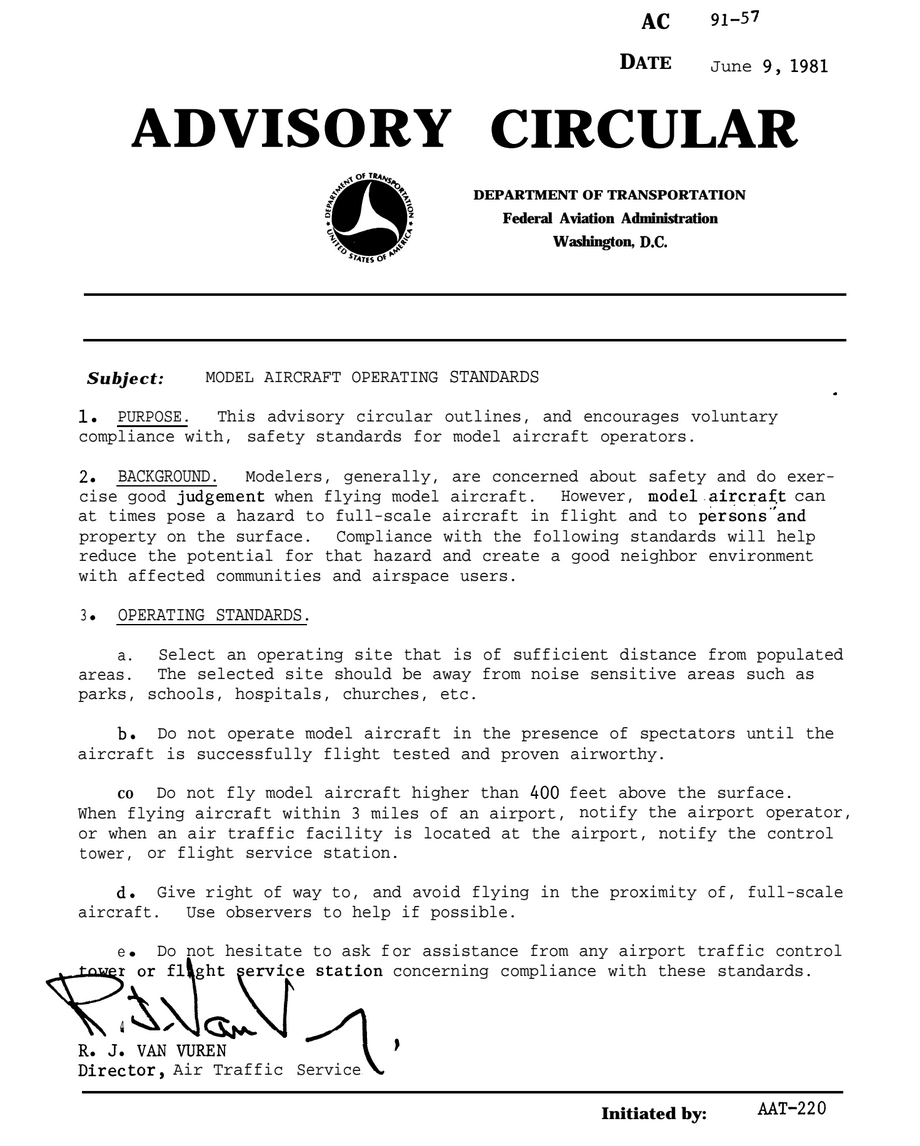
Here's the latest published Interpretation of the Special Rule for Model Aircraft, as of June 18, 2014. A few additional guidelines and descriptions are noted; such as the 3-mile radius from an airport or landing strip is increased to 5 miles (you have to contact the control tower first if you do plan to fly in that range), and they are still trying to lump ALL UAV/UAS into the “under 55lb” category, including fuel-powered drones and other UAS – not taking into consideration the “under 20lb” multirotors that hobbyists and commercial sUAV pilots are actively using.
Also notice they make special distinction between hobbyist and commercial operations:

But the FAA seems to be more interested in the commercial use of sUAVs than they are overal safety of hobbyist craft – which are the very issue of every reported incident or near-miss to date. While serious, commercial operators are taking care and precautions to ensure their expensive multirotors and cameras don't come crashing down. With few exceptions, most commercial sUAV pilots will get training and practice extensively to maintain control of their craft and line up the cameras through FPV monitors to get the shots they need instead of dangerously flying over people and property where there could be a potential for a mishap.
Since this awareness of the increased number of sUAVs across the country and several mishaps that have caught the media's attention, several local, regional and state agencies have issued no fly zones to protect the public and natural open space. It is also now illegal to take off and or land inside a National Park, and you can be cited by a park ranger with a hefty $5000 fine and possibly 6 months jail time. However, since the National Park system does not control the airspace above the park, if you want to take the chance of taking off outside the park's boundaries and flying over, you'd better hope and pray that your craft makes it back safely outside the park again!
But what about commercial use? Why does the FAA allow hobbyist to fly with the exact same sUAVs that commercial pilots are flying with, but has issued an all-out ban on commercial sUAV flight just because there's an exchange of money for services?
When I first attempted to contact the FAA a year ago in November, 2013 to get special authorization for commercial use, this was the actual email repsonse I recieved:
The FAA doesn't regulate the model aircraft industry. This includes the hobbyists that fly model aircraft and the manufacturers that make model aircraft. We only ask that hobbyists comply with Advisory Circular 91-57. While not my area of expertise, I believe flight standards would investigate hobbyists that fly in a careless or reckless manner.”
Obviously, they've changed their minds about this.
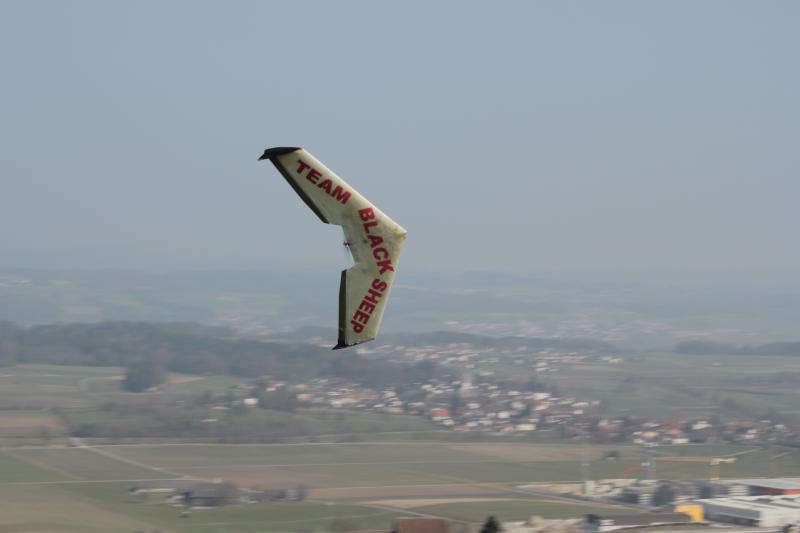
©2014 Team Black Sheep
The Pirker Case
The one case that all eyes have been watching over the past few years and has been responsible for all the media frenzy of late.
In 2011, Raphael Pirker of Team Blacksheep (AKA “Trappy”), a Swiss citizen, was contracted by a publicity firm under contract with the University of Virginia to take aerial videos over and around the campus with his remote controlled powered fixed-wing Styrofoam glider (a Ritewing Zephyr). A couple years later, after viewing his flight online, the FAA levied a $10,000 fine claiming he had operated an UAS for commercial purposes, whcih the FAA does not permit under current regulations for UAVs/UAS in U.S. airspace. They also contended that his flight was reckless and unsafe and many would agree. Trappy is known to fly crazy stunts and dangerously close to people and objects, as you can see in his many videos online. Here is that initial video that started it all:
But because they also contended that Trappy was the pilot in command of the UAS for compensation, which makes it a commercial use.
Pirker appealed the fine, claiming the FAA didn't have regulatory authority over the operation of a “model aircraft” – the case was sent to a law judge for the NTSB (National Transportation Safety Board) to make a decision. The judge's ruling on March 6, 2014 was in Priker's favor to dismiss.
The decision issued March 6, 2014, by Patrick G. Geraghty, granted Pirker’s motion and set aside the fine. The judge’s reasoning included:
- The aircraft Pirker flew is more likely a model aircraft, and by its own advisory circulars, the FAA excludes model aircraft from the more generic term of aircraft. Thus many of the allegations about improper and unsafe operation of the aircraft that the FAA made in its complaint don’t apply.
- Geraghty further noted that the FAA doesn’t actually define or even talk about UAS in any of its regulatory documents. All mention of UAS is only in advisories, primarily written for internal FAA guidance, and as the documents themselves state, not intended to be regulatory. Thus his decision reflects his observation that the FAA can’t take an action against an operator of a type of vehicle that the FAA hasn’t even officially recognized.
- The judge also emphasized that had there been rules or regulations in place (that required mandatory compliance) regarding model aircraft or UAS or where UAS were defined as “aircraft,” then the FAA didn’t follow its required course (as required in the U.S. Code) of issuing a notice of proposed rulemaking (NPRM), soliciting public comment for 30 days, and then issuing the proper rule or regulation.
BUT… that “victory” for the proponents of the commercial UAS was short lived, as just recently the FAA appealed the judge's decision based on safety issues and the decision was overturned.
The FAA appealed an NTSB administrative law judge's decision after the judge dismissed the FAA's order requiring Pirker to pay a civil penalty of $10,000 for allegedly operating an unmanned aircraft in a careless or reckless manner. In his decision, the judge compared Pirker's unmanned aircraft to a model aircraft, and found the FAA had not enacted an enforceable regulation regarding such aircraft.
In reaching its decision, the Board determined the FAA may apply the regulation that prohibits operation of an aircraft in a careless or reckless manner to unmanned aircraft. To determine whether Pirker violated this regulation, however, the Board stated an administrative law judge would need to review evidence showing the operation was careless or reckless.
The public may view the opinion and order on the NTSB website at http://www.ntsb.gov/legal/pirker/5730.pdf
Basically, the NTSB has determined that the definition of an “aircraft” is any “device” “used for flight in the air.” This definition includes any aircraft, manned or unmanned, large or small.
So in a press release issued by the FAA on November 18, 2014:
The National Transportation Safety Board affirmed the agency's position that unmanned aircraft systems (UAS) meet the legal definition of “aircraft,” and that the agency may take enforcement action against anyone who operates a UAS or model aircraft in a careless or reckless manner.
The FAA believes Mr. Pirker operated a UAS in a careless or reckless manner, and that the proposed civil penalty should stand. The agency looks forward to a factual determination by the Administrative Law Judge on the “careless or reckless” nature of the operation in question.
So it's all still left to interpretation and determination of the FAA as to the recklessness of the Pirker case, and all eyes are still on it.
The NTSB did NOT address the issue of “commercial use” of drones/sUAVs.
So where does that leave the rest of us?
Well, if you ask the FAA, you can basically do anything you want within the guidelines as long as you fly safely and don't fly for payment or commercial purposes.
SAY WHAT??!!
That's right. According to the FAA website, you can still fly your model aircraft (weighing less than 55lbs) within all the operation limits of the guidelines stated in the Interpretation of the Special Rule for Model Aircraft as long as there's no commercial attachment.
So what does COMMERCIAL PURPOSE have to do with safety?
Good question! 
So – the FAA DOES claim to allow you to apply for special consideration by applying for a Section 333 exemption which requires you first filing for a COA (Certificates of Waiver or Authorization) in which you must first request to get an account for which to access the online application process and you get passed-on to yet another department/entity and it continues… probably best to get some legal assistance on this process and be prepared to wait in the queue.
But since the FAA has allowed exemptions for a handful of film & TV industry professionals, they've come with a lot of restrictions that a smaller company or independent couldn't possibly meet. Some restrictions demand a two-operator UAS, to last less than 30 minutes and remain under 200 feet on a closed set.
Interestingly though, all seven exemption applications for the film companies were awarded through the same law firm and lawyer.
But no word yet on the FAA's acceptance of the hundreds of other applications sent in through the process, such as construction, geological surveying/study and precision agriculture, which has been booming business in Japan for years now.
Taking Action – Not Standing Still
Not everyone is pleased with the progress (or lack thereof) of the FAA releasing specific guidelines for commercial sUAV/UAS in categories that make sense and with regulation that is both sensible and attainable.
There are several agencies, organizations and entities that are lobbying for these efforts, as well as actually filing suit against the FAA for what they feel is unconstitutional and “arbitrary, capricious, an abuse of discretion, or otherwise not in accordance with law, in excess of statutory jurisdiction, authority, or limitations, and without observance of procedure required by law.”
The AMA has filed suit as they feel the restrictions in the proposed interpretation of the rules is prohibitive to the hobby, as well as manufacturers.
Another group, which includes the UAS America Fund, SkyPan International, FPV Manuals and Peter Sachs with the Drone Pilots Association, which is represented by one of the country's leading drone law experts, Brendan Schulman. According to Schulman, the FAA’s interpretation of the Special Rule for Model Aircraft was meant to tell those who would use models for commercial purposes that “until we have something in place, you shouldn’t do anything at all.”
Peter Sachs states, “Regulations are one thing, outright barriers are another. Congress ordered the FAA to integrate drones into the national airspace system, not exclude them.” And he's not alone in this. A group of Senate lawmakers are putting pressure on the FAA to speed up its efforts in developing reasonable rules for drones. Sen. Ron Wyden (D-Ore.) is leading the charge in a letter that states: “These delays force manufacturers and operators who play by the rules to sit on the sidelines while they wait for approval,” Wyden wrote along with Sens. Jeff Merkley (D-Ore.), Heidi Heitkamp (D-N.D.), John Hoeven (R-N.D.) and Cory Booker (D-N.J.), “while others chance fines and operate without any certification from the FAA, which raises serious concerns about public safety.”
Download a PDF of the actual letter here.
A new entity called the Small UAV Coalition has formed with some serious membership support. As posted on their website mission statement, “The Small UAV Coalition advocates for law and policy changes to permit the operation of small unmanned aerial vehicles (UAVs) beyond the line-of-sight, with varying degrees of autonomy, for commercial, consumer, recreational and philanthropic purposes. Our members, including leading consumer and technology companies such as Airware, Amazon Prime Air, DJI Innovations, Google[x], GoPro, Parrot, and 3DR, believe that U.S. leadership in the research, development, and production of unmanned aerial vehicles will benefit consumers in all walks of life. We believe that, working together, we will be able to remove unnecessary policy or regulatory hurdles that impede small UAV development, sales, job creation, and services.”
UPDATE 12/5/2014: Peter Sachs shared this letter from United States Senator Mark R. Warner sent to the FAA on Dec. 4th, pleading with them to expedite the “development of balanced and reasonable UAS regulations” and places the focus on the financial impact the delays can be causing the commercial aerial photography/videography industry and the jobs that coould be created, along with the taxible income revenue. We can only hope to see more of this type of support in the months ahead!
So what about these proposed new rules the FAA is imposing?
Nobody is seriously going to argue that it should be a free-for-all wild west shootout in the sky where anyone can fly whatever/whenever – so yes, some sort of regulations and accountability for pilots is definitely necessary. Most professionals I've spoken with agree that a realistic testing/licensing system that assures pilots have basic skills and knowledge in place before starting up a drone/sUAV business. Safety and responsibility are of the greatest concern.
But if the rumors are true that the FAA expects to invoke some of these insane restrictions and barriers to entry, such as requiring a manned pilot's license for commercial sUAV use, they can expect a big pushback from the industry and the public. Does it really make sense to force someone to go through months of training and tens of thousands of dollars just to fly an sUAV that they already know how to operate?
The Small UAV Coalition's Executive Director and Advisor, Michael Drobac (Akin Gump Strauss Hauer & Feld) and CyPhy Works CEO Helen Greiner discuss the FAA’s potential rules for commercial drone use on Fox Business:
Peter Sachs adds, “There is nothing wrong with requiring an appropriate level of aeronautical, meteorological and airspace knowledge. That makes sense. However, requiring a manned pilot license to fly a three-pound plastic drone commercially, is like requiring a medical license to apply a Band-Aid. If the reported FAA proposed regulations are actually adopted, the United States is destined to remain a third world nation with respect to drones.”
But for now, there has been no decision – no actual ban – no enforceable actions from the FAA or the NTSB regarding commercial sUAV operation.
So I for one, will continue business as usual: flying safely within the regulated airspace as set-forth by the FAA's guidelines as any other conscious hobbyist would do. But I won't hide the fact that I'm teaching others how to fly and shoot and enjoy this amazing technology. And I will continue to test manufacturers' sUAVs and cameras and speak at conferences, conventions and workshops. And I will show farmers how to use this technology to monitor their crops. And help other businesses and professional photographers and filmmakers learn how this technology can help them create better images and videos. I'm confident the industry will prevail. Go fly my pretties… fly… FLY!
UPDATE 12/5/2014: Check out my interview discussing this topic on THAT DRONE SHOW this week – speaking with David & Sarah Oneal, we look at the article and the state of the industry as a whole.
UPDATE 12/10/12: Committe on Transportation and Infrastructure U.S. Unmanned Aircraft Systems: Integration, Oversight, and Competitiveness
_____________________________________________________________________________________
Jeff Foster is a published author of several how-to books and training videos in the motion graphics, animation and video production industries and is an award-winning video producer and artist. Visit his web site to learn more about his training methods, tips & tricks at PixelPainter.com

Filmtools
Filmmakers go-to destination for pre-production, production & post production equipment!
Shop Now